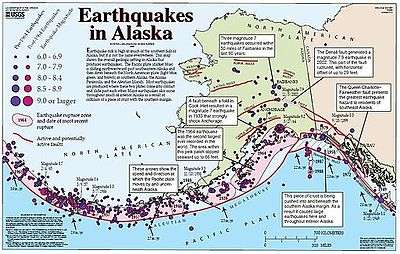1965 Rat Islands earthquake
The 1965 Rat Islands earthquake occurred at 05:01 UTC, on 4 February (19:01, 3 February local time[1]). It had a magnitude of 8.7 and triggered a tsunami of over 10 m on Shemya Island,[2] but caused very little damage.
 | |
| UTC time | 1965-02-04 05:01:22 |
|---|---|
| ISC event | 859206 |
| USGS-ANSS | ComCat |
| Local date | February 3, 1965 |
| Local time | 19:01:22 |
| Magnitude | 8.7 Mw |
| Depth | 30.3 km |
| Epicenter | 51.29°N 178.55°E |
| Areas affected | United States (Alaska) |
| Max. intensity | VI (Strong)[1] |
| Tsunami | 10.7 m (35 ft) |
Tectonic setting
The Rat Islands form part of the Aleutian Islands, a chain of volcanic islands forming an island arc, that results from the subduction of the Pacific Plate beneath the North American Plate. This plate boundary, the Alaska-Aleutian megathrust, has been the location of many megathrust earthquakes.
Characteristics

The 1965 Rat Islands earthquake share common features with the 1963 Kuril Islands earthquake and the 1964 Alaska earthquake.[3]
Earthquake
The earthquake was associated with a 600 km long rupture along the plate boundary, based on the distribution of aftershocks.[4] The pattern of energy release suggest the presence of three asperities along the plate interface, each causing a pulse of moment release. Modelling of the tsunami supports the idea that the earthquake consisted of three sub-events, related to three structural 'blocks' within the overriding plate.[5]
The main shock was followed by an earthquake of magnitude 7.6 nearly two months later, that triggered a small tsunami.[1] This was not an aftershock, but a normal fault event within the outer rise of the subducting plate, triggered by the earlier event.[6]
Tsunami
The tsunami had a maximum run-up height of 10.7 m on Shemya Island, 2.0 m at Amchitka Island, 1.6 m at Attu Island and 1.1 m in northern Kauai, Hawaii. It was also observed in Peru, Ecuador, Mexico, California, Japan and eastern Russia.[1]
Damage
Flooding from the tsunami caused $10,000 worth of damage on Amchitka Island.[2] Minor damage from the earthquake was recorded on both Attu and Shemya islands in the form of cracks in runways.
See also
References
- NGDC. "Search result for 1965 Alaska earthquakes". Retrieved 8 March 2010.
- USGS (26 October 2009). "Historic Earthquakes Rat Islands, Alaska". Archived from the original on 16 January 2010. Retrieved 8 March 2010.
- Wu, Francis T.; Kanamori, Hiroo (1973-10-09). "Source mechanism of February 4, 1965, Rat Island earthquake" (PDF). Journal of Geophysical Research. 78 (26): 6082–6092. doi:10.1029/jb078i026p06082. ISSN 0148-0227.
- Beck, S.L.; Christensen D.H. (1991). "Rupture Process of the February 4, 1965, Rat Islands Earthquake". Journal of Geophysical Research. 96 (B"): 2205–2221. Bibcode:1991JGR....96.2205B. doi:10.1029/90JB02092.
- Johnson, J.M. (1999). "Heterogeneous coupling along Alaska-Aleutians as inferred from Tsunami, Seismic and Geodetic Inversions". In Dmowska R. & Saltzman B. (ed.). Tsunamigenic Earthquakes and Their Consequences. Advances in Geophysics. 39. pp. 28–55. ISBN 978-0-12-018839-0.
- Abe, K. (1972). "Lithospheric normal faulting beneath the Aleutian trench". Physics of the Earth and Planetary Interiors. 5: 109–198. Bibcode:1972PEPI....5..190A. doi:10.1016/0031-9201(72)90091-X.
External links
- The International Seismological Centre has a bibliography and/or authoritative data for this event.